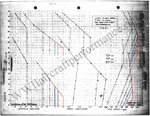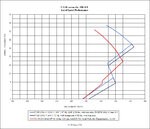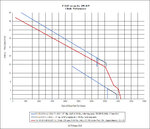Mike Williams
Senior Airman
- 572
- Oct 19, 2006
Further reading about the change over to 100 octane by the RAF and the increases in performance obtained therefrom:
Alec Harvey-Bailey, The Merlin in Perspective, (Rolls-Royce Heritage Trust, Derby, 1983), p. 85.
W.G. Dudek and D. R. Winans, excerpt from AIAA Paper No. 69-779, Milestones in Aviation Fuels, (Esso Research and Engineering Company, New York 1969.) p. 319.
A. R. Ogston, excerpt from History of Aircraft Lubricants (Society of Automotive Enginees, Inc. Warrendale, PA USA), p. 12.
Hundred Octane, Flight, No. 1631 Vol. XXXVII, The Outlook, March 28, 1940.
H. F. King, Fighter Station, With the Spitfires in Scotland, (Flight, No. 1631 Vol. XXXVII, March 28, 1940), pp. 290-295.
"Aero", Correspondance, (Flight, January 6th 1944), p. 22.
Air Commodore F. R. Banks, I Kept No Diary , Airlife Publications, Shrewsburg, 1978, Appendix II Fuel pp 234-236
Leo McKinstry, Hurricane, Victor of the Battle of Britain, (John Murrey Publishers, London, 2010), p. 87.
Leo McKinstry, Hurricane, Victor of the Battle of Britain, (John Murrey Publishers, London, 2010), p. 191.
Robert Schlaifer, Development of Aircraft Engines, (Harvard University, Boston, 1950), pp.220-223
Fuels and Lubricants Handbook: Technology, Properties, Performance, and Testing, (ASTM International, 2003). P. 89
Dik A. Daso, Doolittle: Aerospace Visionary, (Potomac Books, Washington D.C, 2003), p. 38.
Bill Gunston, Rolls-Royce Aero Engines, (Patrick Stephens Limited, 1989). p. 72.
Alfred Price, The Spitfire Story, (Arms and Armour Press Ltd., London, 1986), p. 74.
Dr. Alfred Price, Spitfire Mark I/II Aces 1939-41, (Osprey Publishing, 1996), p. 19.
Richard P. Hallion, "The American Perspective", in Paul Addison and Jeremy A. Crang (eds), The Burning Blue. A New History of the Battle of Britain (Pimlico, London 2000), p. 84.
David Ross, The Greatest Squadron of Them All, The Definitive History of 603 Squadron, RAauxAF, (Grub Street, London, 2003), p. 125.
Gavin Bailey, The Arsenal of Democracy: Aircraft Supply and the Evolution of the Anglo-American Alliance, 1938-1942, (Edinburgh University Press, 2013), p. 104.
Sir Stanley Hooker, Not Much of an Engineer, (Airlife Publishing, Ramsburg, Marlborough, Wiltshire, 2002), p50.
Wing Commander George Kerr, Time's Forlock, (The Shell Petroleum Company Limited, London, 1948). pp. 36-38.
Peter Pugh, The Magic of a Name, The Rolls-Royce Story, The First 40 years, (Icon Books, London, 2000), pp. 189-190; 229-230.
Alec Harvey-Bailey, The Merlin in Perspective, (Rolls-Royce Heritage Trust, Derby, 1983), p. 85.
W.G. Dudek and D. R. Winans, excerpt from AIAA Paper No. 69-779, Milestones in Aviation Fuels, (Esso Research and Engineering Company, New York 1969.) p. 319.
A. R. Ogston, excerpt from History of Aircraft Lubricants (Society of Automotive Enginees, Inc. Warrendale, PA USA), p. 12.
Hundred Octane, Flight, No. 1631 Vol. XXXVII, The Outlook, March 28, 1940.
H. F. King, Fighter Station, With the Spitfires in Scotland, (Flight, No. 1631 Vol. XXXVII, March 28, 1940), pp. 290-295.
"Aero", Correspondance, (Flight, January 6th 1944), p. 22.
Air Commodore F. R. Banks, I Kept No Diary , Airlife Publications, Shrewsburg, 1978, Appendix II Fuel pp 234-236
Leo McKinstry, Hurricane, Victor of the Battle of Britain, (John Murrey Publishers, London, 2010), p. 87.
Leo McKinstry, Hurricane, Victor of the Battle of Britain, (John Murrey Publishers, London, 2010), p. 191.
Robert Schlaifer, Development of Aircraft Engines, (Harvard University, Boston, 1950), pp.220-223
Fuels and Lubricants Handbook: Technology, Properties, Performance, and Testing, (ASTM International, 2003). P. 89
Dik A. Daso, Doolittle: Aerospace Visionary, (Potomac Books, Washington D.C, 2003), p. 38.
Bill Gunston, Rolls-Royce Aero Engines, (Patrick Stephens Limited, 1989). p. 72.
Alfred Price, The Spitfire Story, (Arms and Armour Press Ltd., London, 1986), p. 74.
Dr. Alfred Price, Spitfire Mark I/II Aces 1939-41, (Osprey Publishing, 1996), p. 19.
Richard P. Hallion, "The American Perspective", in Paul Addison and Jeremy A. Crang (eds), The Burning Blue. A New History of the Battle of Britain (Pimlico, London 2000), p. 84.
David Ross, The Greatest Squadron of Them All, The Definitive History of 603 Squadron, RAauxAF, (Grub Street, London, 2003), p. 125.
Gavin Bailey, The Arsenal of Democracy: Aircraft Supply and the Evolution of the Anglo-American Alliance, 1938-1942, (Edinburgh University Press, 2013), p. 104.
Sir Stanley Hooker, Not Much of an Engineer, (Airlife Publishing, Ramsburg, Marlborough, Wiltshire, 2002), p50.
Wing Commander George Kerr, Time's Forlock, (The Shell Petroleum Company Limited, London, 1948). pp. 36-38.
Peter Pugh, The Magic of a Name, The Rolls-Royce Story, The First 40 years, (Icon Books, London, 2000), pp. 189-190; 229-230.



